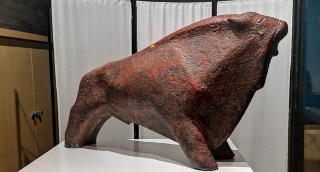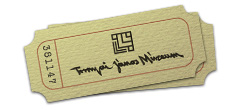Local History Collection
Local History
The Local History Collection of the János Tornyai Museum was created on the 1st July 1963. Following the appointment of János Dömötör as director on the 16th November 1961, began a deliberate enrichment of the local history collection, starting by purchasing legacies including relics prior to 1945. Thanks to this project, the collection has grown significantly, and now has more than 8,900 pieces of inventiored objects. One of the oldest relics dates from 1491: a diploma issued by II. Wladislaw for a cobbler's guild in Szeben / Sibiu.
The collecting of local historical material, of course, did not start as late as 1963. When the museum opened its gates on the 1st July 1928, the ethnographic exhibition included many objects that are currently part of the local history collection.
Due to the political changes following World War II, many political, economic and cultural organizations were banned and dissolved. A relatively large stock of relics and documents of these dissolved organizations were transferred into the museum.
The largest and most important part of the collection is made up of the legacy of guilds, the Craftsmen’s Society, the Craftwomen’s Association - more than 2,000 pieces. Some of the guild materials have already been in the possession of the museum before 1928, another part of it was donated by the local branch of KIOSZ in 1949-1950, and finally a small part came from the local group of the Building, Wood and Construction Material Workers Union in 1956. After 1963, the collection was also enriched by the purchases of János Dömötör.
Nearly all documents of the local guilds are now part of the museum’s local history collection. The most valuable pieces of the collection are the eighteen guild chests. In this collection you can find many guilds and craftsmen’s corporation seals, wood and metal draft-plates, guild patents and traveling books, minutes, reckoning books, cash books, Master Letters and Master Letters’ prints, fine drawings, guild and craftsmen’s corporation flag with ribbons. The photographic tableaux of the Craftmen’s Society, the Craftmen’s Corporation and the Craftswomen’s Association, made between 1907-1942, all show well-known local figures of the contemporary public life.
A local teacher, Pál Csókán spent decades to gather all existing newspaper in town and other publications which once appeared in Hódmezővásárhely. In 1940 he exhibited the collection in the city. Unfortunately, the majority of the over three thousand pieces of printed material was later destroyed. Only 679 pieces made it to the local history collection: posters, election leaflets, invitations, obituaries, announcements, pamphlets, newspapers, and maps – all printed between 1884 and 1940. Although this is only a small fraction of the original collection, it still provides an insight to the contemporary political, social and cultural life.
Thanks to the donations of enthusiastic local patriots and the well-planned purchases of János Dömötör, the museum managed to preserve a good number of well-known local citizens’ legacy for posterity. We also take good care of János Tornyai’s personal belongings: his gold medal diploma won at the 1929 World Exhibition in Barcelona, his Bible containing family birth data, some correspondence, family photos, his suitcase, his painted chest, his zither and books.
In 1961, ethnographer Lajos Kiss - our first curator - donated to the museum his elementary school and high school copybooks, and other prints and works, including the Certificate of Membership of the Tornyai Society dating from 1934. After death, his notes, prints of his works, awards – Kossuth Prize from 1948, Work Order of Merit from 1961, correspondence, family photographs, pictures of his teachers, artist friends, and the town of Hódmezővásárhely at the turn of the century, family papers and his desk have been all included in the collection of the museum.
Valuable pieces of the local history collection are Béla Czutor’s (Béla, the gypsy) pocket watch, his violin made by Mathias Albani, and the laurel wreath won at the violin competitions arranged in memory of Pista Dankó in Szeged, in 1903.
| Tornyai János Múzeum | |
| 6800 Hódmezővásárhely, Dr. Rapcsák András út 16-18. | |
| Telefon: | +36 62 242 224 |
| E-mail: | tjm@tjm.hu |
| Térkép: |  |




